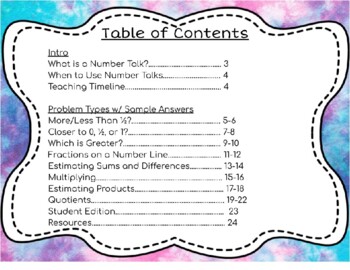Help! I have to teach Fractions! (Number Talks)
TEAM Z
49 Followers
Grade Levels
4th - 8th
Subjects
Resource Type
Standards
CCSS4.NF.A.1
CCSS4.NF.A.2
CCSS4.NF.B.3a
CCSS4.NF.B.3b
CCSS4.NF.B.3c
Formats Included
- PDF
TEAM Z
49 Followers
Description
Want to teach your students a conceptual understanding of fractions rather than just showing them rules, procedures, and algorithms? Start with this product, which can be a great addition to your current curriculum and can be used as a warmup each day in math class.
Struggle to understand fractions yourself? The teacher's guide walks you through 8 different problem types and gives sample student answers to help you build your conceptual understanding of fractions as well.
Includes....
- 24 Page Teacher's Edition PDF explaining what number talks are and gives many example problems with sample student responses.
- 7 Student Edition Google Jamboards that can be shared virtually or in person.
Total Pages
Answer Key
Not Included
Teaching Duration
N/A
Report this resource to TPT
Reported resources will be reviewed by our team. Report this resource to let us know if this resource violates TPT’s content guidelines.
Standards
to see state-specific standards (only available in the US).
CCSS4.NF.A.1
Explain why a fraction 𝘢/𝘣 is equivalent to a fraction (𝘯 × 𝘢)/(𝘯 × 𝘣) by using visual fraction models, with attention to how the number and size of the parts differ even though the two fractions themselves are the same size. Use this principle to recognize and generate equivalent fractions.
CCSS4.NF.A.2
Compare two fractions with different numerators and different denominators, e.g., by creating common denominators or numerators, or by comparing to a benchmark fraction such as 1/2. Recognize that comparisons are valid only when the two fractions refer to the same whole. Record the results of comparisons with symbols >, =, or <, and justify the conclusions, e.g., by using a visual fraction model.
CCSS4.NF.B.3a
Understand addition and subtraction of fractions as joining and separating parts referring to the same whole.
CCSS4.NF.B.3b
Decompose a fraction into a sum of fractions with the same denominator in more than one way, recording each decomposition by an equation. Justify decompositions, e.g., by using a visual fraction model. Examples: 3/8 = 1/8 + 1/8 + 1/8; 3/8 = 1/8 + 2/8; 2 1/8 = 1 + 1 + 1/8 = 8/8 + 8/8 + 1/8.
CCSS4.NF.B.3c
Add and subtract mixed numbers with like denominators, e.g., by replacing each mixed number with an equivalent fraction, and/or by using properties of operations and the relationship between addition and subtraction.





